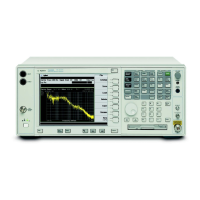Chapter 3 71
Troubleshooting the RF Section (E4440A, E4443A, E4445A)
RF Section Description (E4440A, E4443A, E4445A)
RF Section Description
(E4440A, E4443A, E4445A)
Purpose
The RF front end section converts input signals to a 3
rd
IF of 21.4 MHz.
This section contains assemblies which generate Local Oscillator (LO)
signals and assemblies which use the LO signals to mix the RF Input
and the subsequent IF signals. Assemblies in the RF section also
provide attenuation and circuit protection, gains and trigger signals,
and a path for the 50 MHz calibrator signal.
RF Block Diagram (E4440A Example)
The 3 Hz to 26.5 GHz RF input signal first enters the input
attenuators, A14 and A15. The input attenuators provide 0 to 70 dB
attenuation in 2 dB steps. In addition, a selectable DC block and a
switch for the calibrator signal are contained in the input attenuator
block. With the DC block switched in (AC coupling), the frequency
range is limited to 20 MHz to 26.5 GHz. The calibrator path supports a
50 MHz, −25 dBm signal for absolute amplitude calibration.
After passing through the input attenuators, the RF signal routes to
one of two major RF paths; High Band for frequencies above 3 GHz and
Low Band for frequencies below 3 GHz. The A19 RYTHM (Routing
YIG-Tuned Harmonic Mixer) is where the two major RF paths diverge.
For the High Band path, the signal continues through the RYTHM
where it first passes through the YIG Tuned Filter (YTF). The YTF
tracks the displayed center frequency as the instrument sweeps and
removes spurious signals such as images and multiples. Next the signal
is down-converted to the 321.4 MHz IF using the harmonically-pumped
High Band mixer. The IF signal then routes out of the RYTHM and into
the Third Converter board.
For the Low Band path, the 3 Hz to 3 GHz signals leave the input
switch in the RYTHM and continue through to the FL1 3 GHz Lowpass
filter. If the instrument contains Option 1DS (preamplifier) or Option
B7J (digital demod hardware), the low band signal also routes through
them. The signal then enters the A20 LowBand assembly.
The Lowband assembly contains both the first and second mixer. The
first mixer up-converts the RF signal to the 3.9214 GHz first IF. The
first IF signal leaves the Lowband assembly and routes through the
3.9214 GHz bandpass filter FL2, and back into the Lowband assembly
at the first IF input port. The second mixer down-converts the first IF
to the 321.4 MHz second IF. The second IF signal then routes to the A10
Third Converter assembly.

